The Grand Egyptian Museum (GEM), located near the Giza Pyramids, is set to become the world’s largest museum devoted to a single civilization when it fully opens in 2025. Valued at $1.1 billion and designed by Heneghan Peng, the museum will showcase over 100,000 artifacts, including the full collection of King Tutankhamun. Blending ancient heritage with modern design, GEM features cutting-edge exhibits, restoration labs, gardens, a children’s museum, and educational facilities. Partial tours are currently available during its soft opening phase.

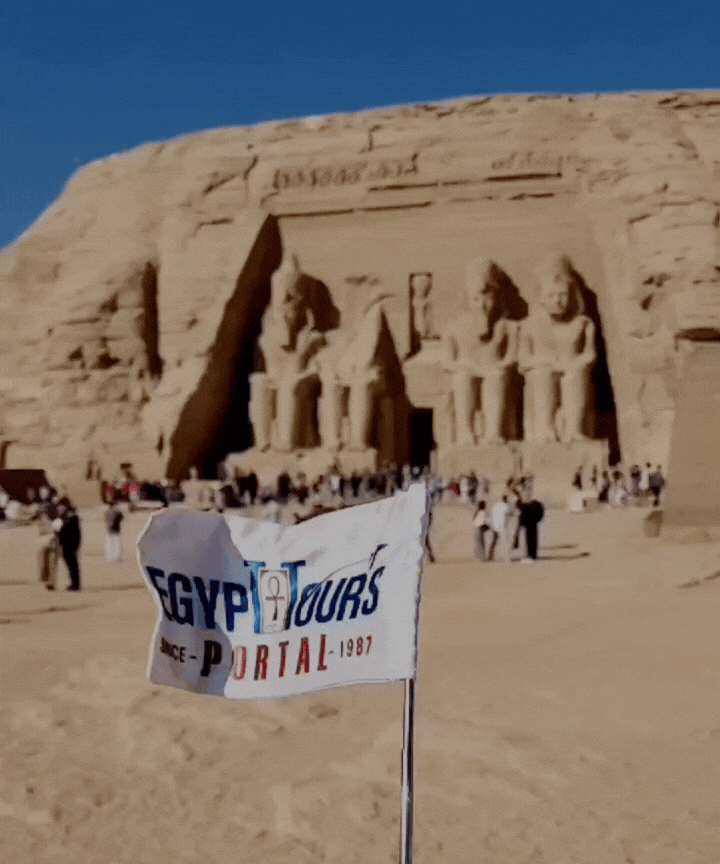
The Grand Egyptian Museum (GEM) is a realm of divine creations made of pure magic and wonder that displays artistic awakenings, mythological beliefs, and historical progress. It is a planned museum of ancient Egypt artifacts, a means to ensure these treasures will be able to survive for various generations to come.
Described as the largest archaeological museum in the world, able to sustain 5 million visitors a year, the museum is under construction and is scheduled to be partially open in 2025, exhibiting the full King Tutankhamun collection with various pieces to be displayed for the first time ever. The cost of the museum is one billion dollars, which is mostly financed by two loans from the Japanese government for a total amount of 300 million dollars.

The design of the building was decided by means of an architectural competition, just like the Great Library of Alexandria. The competition was announced on 7 January 2002 by the organizers, who received 1557 entries from 82 countries, which makes it the second-largest architectural competition in history. In the second stage of the competition, exactly 20 entries were asked to submit additional information about their design. Judging was completed by 2 June 2003. The company Heneghan Peng from Dublin, Ireland, won the competition, winning 250,000 dollars, and the chance to witness their design come to life.
The structure of the gem museum was built by the Belgian company BESIX, which founded a joint venture with Orascom Construction (OC) as the official contractor for a cost of $810 million. The architects Róisín Heneghan and Shi-Fu Peng, who created the Irish company Heneghan Peng, were hired as the main architects. The main Structural engineer was Arup, and the Services engineer was Buro Happold. To witness the milestones of the gem, everyone can book our incredible Egypt tours.
The Grand Egyptian Museum, a landmark of modern Egyptology, is strategically located just 2 kilometers northwest of the iconic Giza Pyramids complex, offering visitors a unique experience that combines ancient wonders with contemporary architectural brilliance. Situated only 15 kilometers from Cairo’s bustling city center, the museum is easily accessible by car, making it a convenient destination for travelers and locals alike.
Its proximity to the Pyramids allows guests to explore Egypt’s most celebrated ancient treasures, including King Tutankhamun’s complete collection, all within a short distance from the grand structures that have fascinated the world for millennia. This ideal location allows visitors to immerse themselves in Egypt's rich history and culture, making it an essential stop on any journey through Cairo.
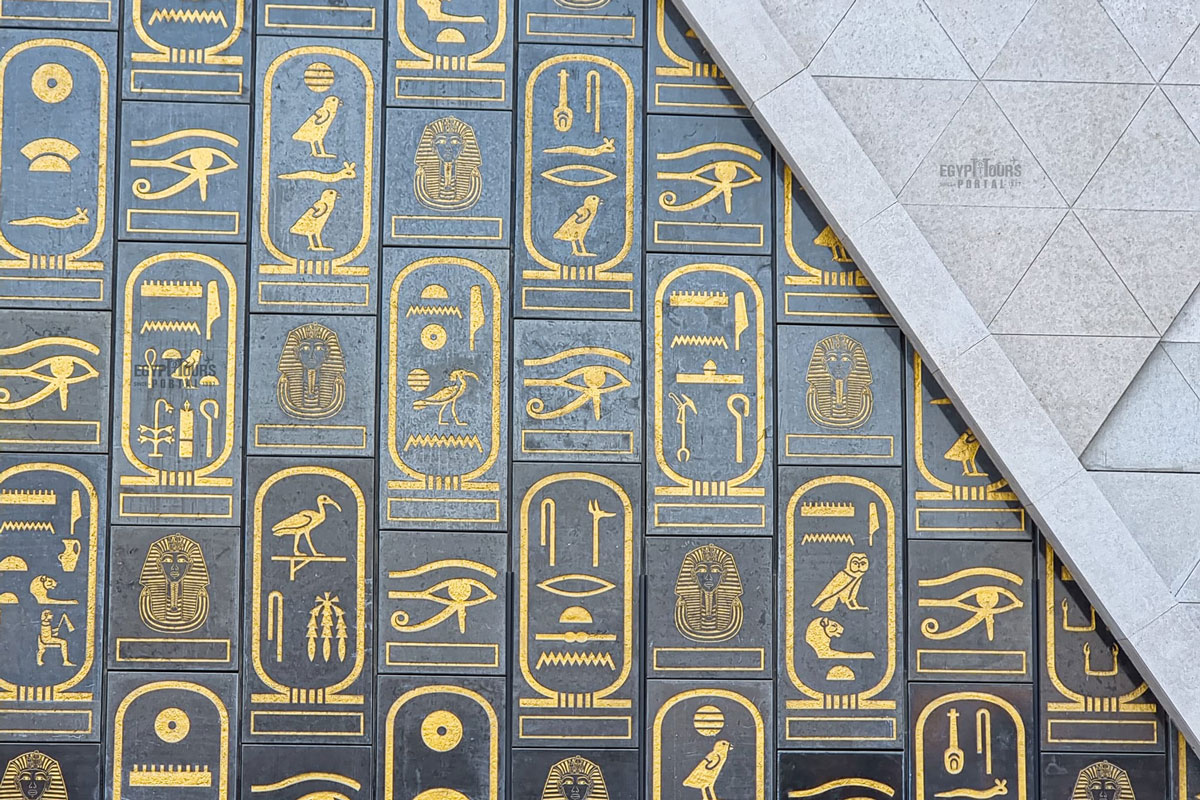
The design of the museum utilizes the level difference to construct a new "Edge" to the plateau, a surface defined by a veil of translucent stone that magically transforms from day to night. The museum exists between the level of the Nile River and the plateau, never extending above the whole plateau. It sits on a site 2 km west of the Giza pyramids, and funerary monuments near a motorway interchange. The building's north and south walls line up perfectly with the Great Pyramid of Khufu and the Pyramid of Menkaure.
- The Grand Egyptian Museum is designed to include the latest advanced technology, such as virtual reality, virtual augmentation, interactive exhibits, 3D models, and more.
- The museum will also be an international center of communication between other Egyptian museums, to promote direct contact with other local and international museums.
- It holds 122 highly advanced displays designed by an Italian company, "Goppion" to offer ideal protection to all the organic, artistic, and fragile artifacts.
- It holds the 3200-year-old, 82-ton statue of Ramses the Great within its atrium, and there is a hall dedicated to the Solar boat of King Khufu; both were transported from the Giza Complex.
- The Grand Egyptian Museum will contain a children's museum, conference center, training center, and workshops similar to the old Pharaonic places.
- One of the most important areas in the museum will be the restoration center, which is in a space of 32 thousand square meters, 10 meters underground, and connected by a 300 m tunnel to the museum for transporting the artifacts after restoration.
- There are about 19 laboratories that will handle all types of preserving and restoring artifacts, such as a vase, glass, and metal lab, which, of course, handles all artifacts, vessels, or statues made from non-organic substances.
- A wood lab that handles all the restoration of artifacts made out of wood, like ancient Egyptian coffins, statues, funerary objects, tools, ships, and sarcophagi.
- A stone lab, which of course takes care of all the statues on display from the colossal to the smallest ones.
- Microbiological lab protects the artifacts by discovering the types of living creatures that could destroy the artifacts, which the researchers eliminate by creating a chemical matter that will stop the progress of this life form from hurting the artifact.
- A microscope scanner lab that holds all the tools needed for preparing and examining the samples before sending them to the microbiological lab.
- A Human remains lab "Mummies Lab" is responsible for restoring all the ancient Egyptian mummies of all the kings, queens, workers, and even animals like cats & birds.
- The exterior design of the museum is intended to be a modern interpretation of classic ancient Egyptian architecture, while also being environmentally sustainable. Here are some of the key features of the exterior design:
The museum's main building is shaped like a triangular pyramid, with a sloping roof that rises to a height of around 50 meters. The pyramid shape is an homage to the ancient pyramids of Egypt, which have become a symbol of the country's rich cultural heritage. The exterior of the museum is clad in a high-performance glass façade, which allows natural light to flood the interior of the building. The glass also helps to regulate the temperature inside the museum, reducing the need for artificial cooling. It is decorated with laser-cut limestone across its epic exterior.
The museum's roof is covered in solar panels, which generate renewable energy to power the building's lighting and other electrical systems. The solar panels are arranged in a way that mimics the pattern of the Nile River delta, further emphasizing the connection between the museum and Egypt's natural environment. Its grounds feature a series of gardens and landscaped areas, which help to cool the surrounding environment and promote biodiversity. The gardens also include a number of native Egyptian plants, which provide a connection to the country's natural heritage.
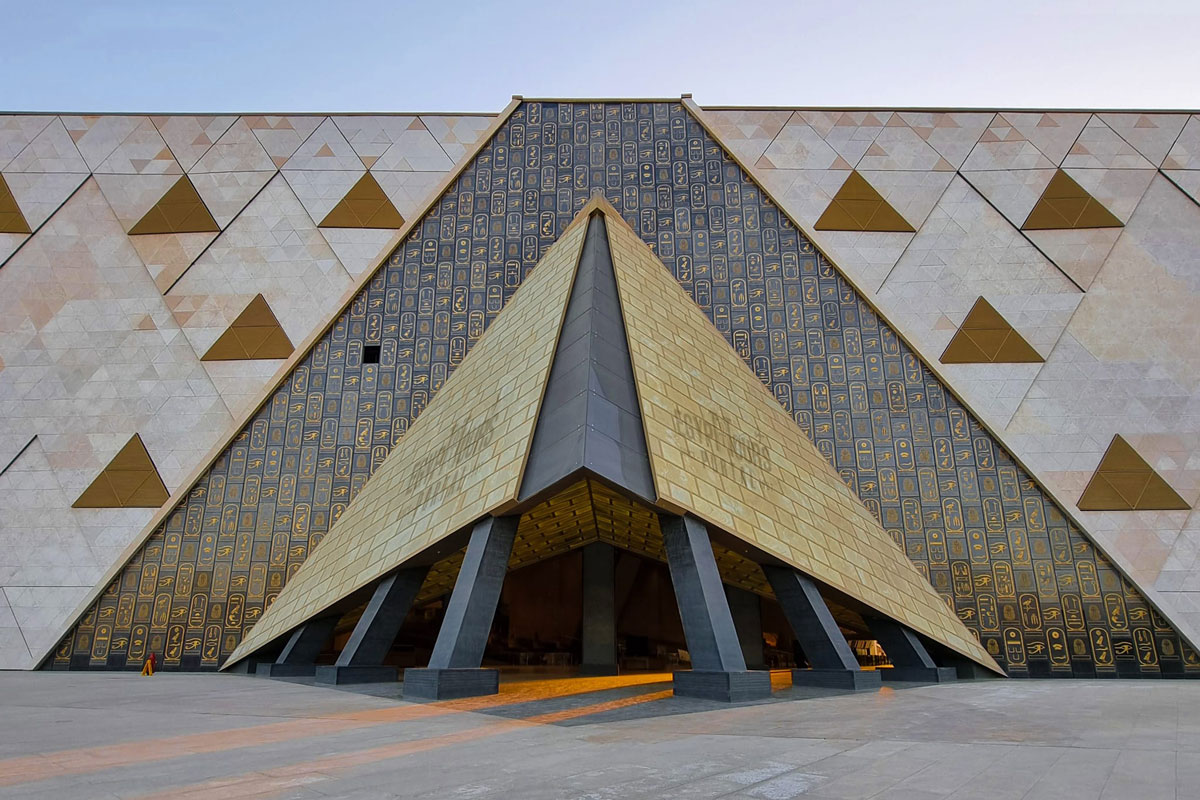
The Grand Egyptian Museum is on 480,000 square meters (5,200,000 sq ft) with a floor area of 81,000 square meters (870,000 sq ft), approximately 2 km (1.2 miles) northwest of the Giza pyramids, 15 km from Cairo, and is part of a new master plan for the plateau. In front of the building is a large plaza, filled with many date plants. One of the main features of the museum is the translucent stone wall, made of pure alabaster, which makes up the front facade of the building.
Inside the main entrance of the museum is a large atrium, where large statues will be exhibited. The Grand Egyptian Museum is foreseen as a cultural complex of activities devoted to Egyptology as it will contain 24,000m² of permanent exhibition space, almost 4 football fields in size, a children’s museum, a larger conference center, and education facilities, plus extensive gardens on the 50h A site.
The actual work began on 2 February 2010 when Hill International announced that Egypt's Ministry of Culture had signed a contract with a joint venture of Hill and EHAF Consulting Engineers to provide project management services during the period of design and construction of the Grand Egyptian Museum.
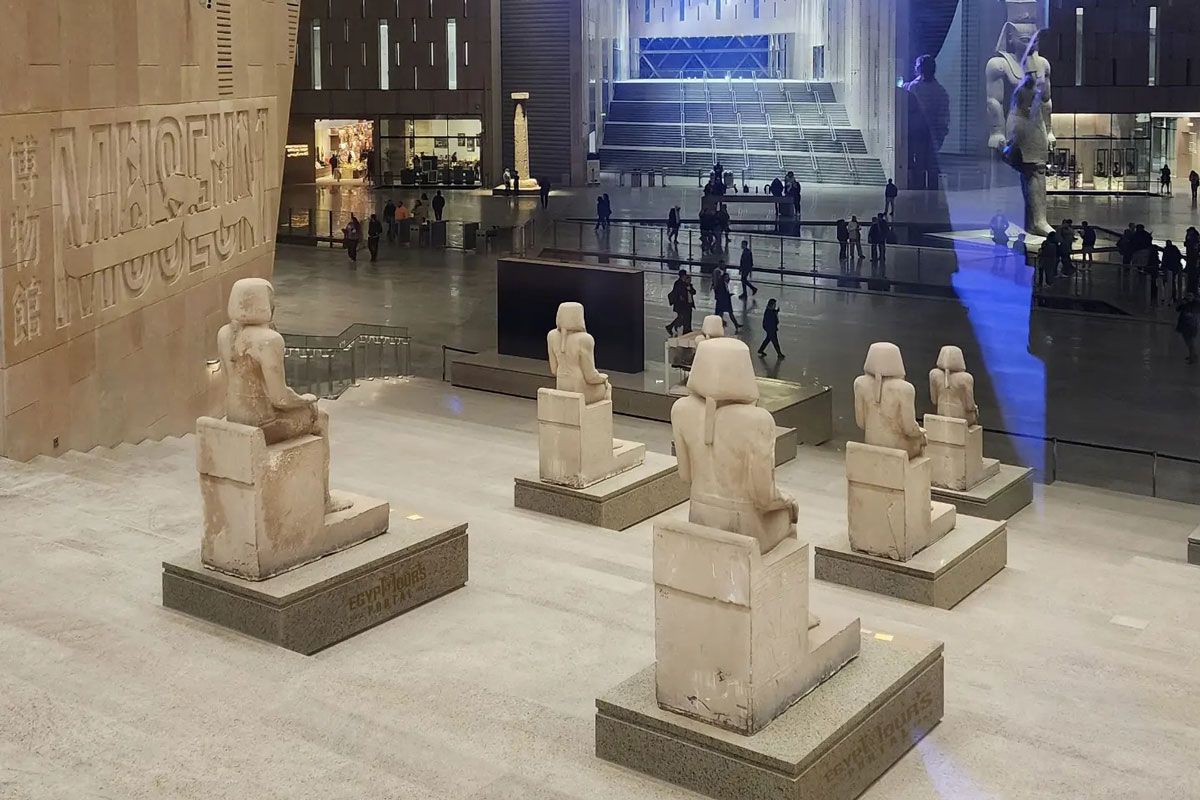
On 5 January 2002, Egyptian President Hosni Mubarak laid the foundation stone of the Grand Egyptian Museum. On 25 August 2006, the Statue of King Ramesses II was moved from Ramses Square to the Giza Plateau in Cairo, in anticipation of the construction of the Grand Egyptian Museum. The Statue of Ramesses II is estimated to be about 3,200 years old and was moved to the entrance of the museum in January 2018.
In 2007, GEM secured a $300 million loan from the Japan Bank for International Cooperation. The Egyptian Government will fund $147 million, while the remaining funds were secured through donations and international organizations.
On 11 January 2012, a joint venture between Egypt's Orascom Construction Industries (OCI) and the Belgian BESIX Group began as it was awarded the contract for phase three of the Grand Egyptian Museum (GEM), a deal valued at $810 million, bringing the total cost of the museum to $1.1 billion.
On 29 April 2018, a fire broke out near the entrance of the GEM, but artifacts were not damaged, and the cause of the fire remains unknown.
In May 2018, the last of King Tutankhamun's chariots were moved to GEM from overseas.
In November 2018, the estimate for a full official opening was set for late 2023, according to Tarek Tawfik, GEM’s director.
In early 2023, the gem museum announced a number of tours leading to some of the displays during the soft opening.

There are 4-time slots available in the soft opening, which are open every single day. Everyone will explore the gem in a two-hour exploration session from 10 am — 12 pm, and 2 pm — 4 pm. There is a light show that takes place at 6 pm after sunset. In order to book a trip to the Grand Egyptian Museum, everyone should contact the team of Egypt Tours Portal at any time.
| Price of the GEM for Egyptian Adults | 150 LE |
| Price of the GEM for Child/Student | 75 LE |
| Price of the GEM for Foreign Adults | 1000 LE |
| Price of the GEM for Foreign Child/Student | 500 LE |
| Price of the VIP GEM Tour | 2000 USD - Two Thousand Dollars |
| Price of the GEM Light Show for the Young | 2500 LE |
| Price of the GEM Light Show for the Adult | 4500 LE |
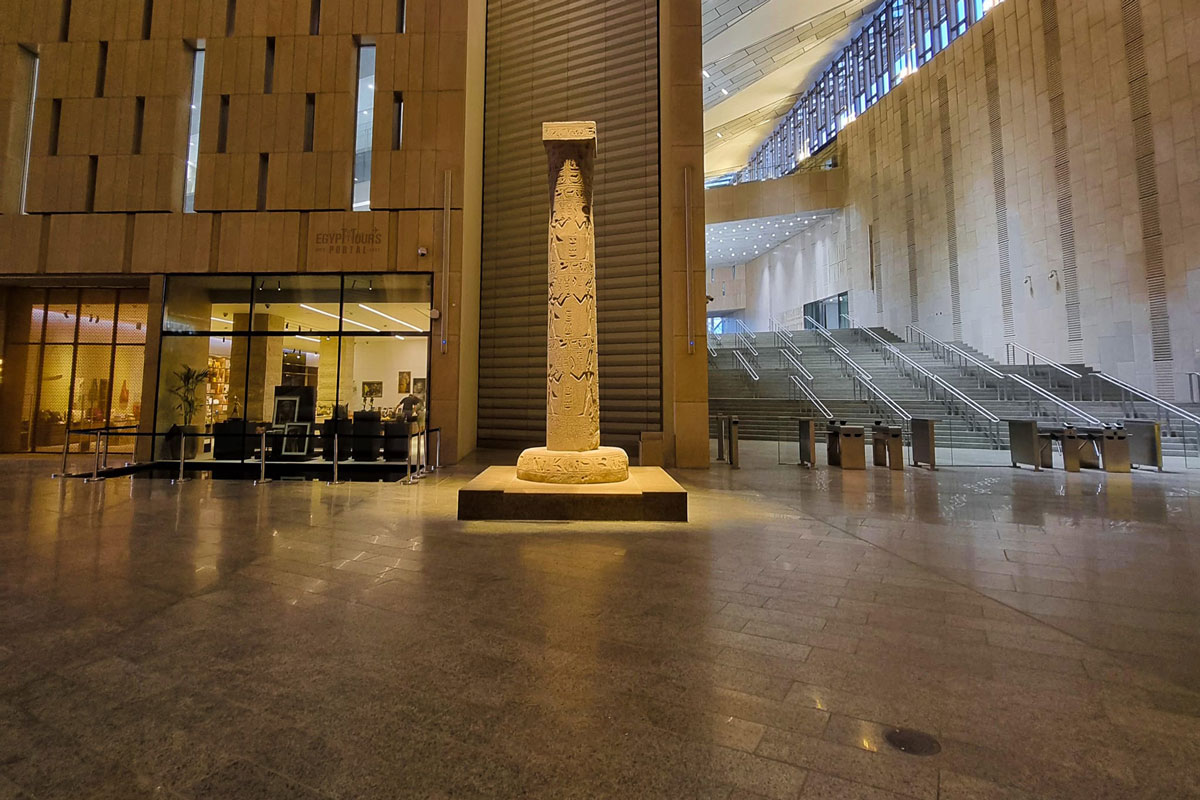
The museum will cover about one-third of the total museum grounds, displaying more than 100,000 artifacts from various periods, some of which have never been seen before. The main attraction of the museum will be the first exhibition of the full tomb collection of King Tutankhamun, which will showcase about 5000 items in total and will be relocated from the Egyptian Museum in Cairo.
Other artifacts will be relocated from storages and museums in Luxor, like the great statue of Amenhotep III and a four-ton pink Granite statue of the god Horus, Aswan, Minya, Sohag, Assiut, Beni Suef, Fayoum, the Delta, and Alexandria.
During the limited tour of the soft opening, everyone will cast their eyes on the following, which include:
Check out our Grand Egyptian Museum tours and book your dream vacation to Egypt to explore what Egypt has to offer at the Grand Egyptian Museum. Also, we offer Nile river cruises to check them out if you prefer.
Tour to the Grand Egyptian Museum & Giza Pyramids from Cairo for Australian Trave...
Tour Location: Giza - Cairo...
Stunning Cairo Day Tour Includes the NMEC for Australian Travelers Best of Cairo inc...
Tour Location: Giza - Cairo...
Tour to the Grand Egyptian Museum for Australian Travelers Half-Day tour to the Gran...
Tour Location: Giza, Cairo...
Luxury VIP tour to the Grand Egyptian Museum for Australian Travelers A VIP tour to ...
Tour Location: Giza, Cairo...
The duration of a Grand Egyptian Museum tour can vary depending on the depth of exploration and whether you opt for a guided tour or a self-guided visit. A typical guided tour might last around 2-3 hours, while a self-guided visit could take anywhere from a few hours to a full day.
No, the Grand Egyptian Museum is not the biggest in the world by floor area. However, it is one of the largest museums in the world dedicated to a single civilization and holds the record for the largest museum in the world by display area.
The Grand Egyptian Museum is primarily funded by the Egyptian government, with some contributions from international donors and sponsors.
The Grand Egyptian Museum boasts several unique features:
Grand Staircase: A monumental staircase leading to the upper floors, adorned with ancient Egyptian motifs.
Tutankhamun Gallery: A dedicated gallery showcasing the treasures of King Tutankhamun, including his golden mask and sarcophagus.
Panorama: A panoramic view of the Giza Pyramids from the museum's rooftop.
Conservation Laboratories: Visitors can observe the restoration and conservation of artifacts in real-time.
Children's Museum: An interactive space for children to learn about ancient Egyptian history.
Tutankhamun's mummy remains in the Grand Egyptian Museum, housed within a climate-controlled display case in the Tutankhamun Gallery.
The iconic statue in the Grand Egyptian Museum is the colossal statue of Ramses II, one of the most powerful pharaohs of ancient Egypt.
The Grand Egyptian Museum houses over 100,000 artifacts, making it one of the largest collections of ancient Egyptian artifacts in the world.
The entire country of Egypt deserve to be explored with its every heavenly detail but there are places that must be seen before any other such as the breathtaking Hurghada's red sea, The wonders of Cairo the pyramids of Giza, the great sphinx, the Egyptian Museum, Khan El Khalili Bazaar, the wonders of Luxor like Valley of the Kings, Karnak & Hatshepsut temple and the wonders of Aswan such as Abu Simbel temples, Philea temple, Unfinished obelisk and The Wonders of Alexandria like Qaitbat Citadel, Pompey's Pillar and Alexandria Library. Read more about the best places to visit in Egypt.
If you want to apply for a Visa On Arrival that lasts for 30 days then you should be one of the eligible countries, have a valid passport with at least 6 months remaining and pay 25$ USD in cash, as for the E-Visa for 30 day you should have a valid passport for at least 8 months, complete the online application, pay the e-visa fee then print the e-visa to later be presented to the airport border guard. You could also be one of the lucky ones who can obtain a free visa for 90 days. Read more about Egypt travel visa.
Egypt has a variety of delicious cuisines but we recommend “Ful & Ta’meya (Fava Beans and Falafel)”, Mulukhiya, “Koshary”, a traditional Egyptian pasta dish, and Kebab & Kofta, the Egyptian traditional meat dish.
The best time to travel to Egypt is during the winter from September to April as the climate becomes a little tropical accompanied by a magical atmosphere of warm weather with a winter breeze. You will be notified in the week of your trip if the Climate is unsafe and if any changes have been made.
You should pack everything you could ever need in a small bag so you could move easily between your destinations.
We have been creating the finest vacations for more than 20 years around the most majestic destinations in Egypt. Our staff consists of the best operators, guides and drivers who dedicate all of their time & effort to make you have the perfect vacation. All of our tours are customized by Travel, Financial & Time consultants to fit your every possible need during your vacation. It doesn't go without saying that your safety and comfort are our main priority and all of our resources will be directed to provide the finest atmosphere until you return home.
You will feel safe in Egypt as the current atmosphere of the country is quite peaceful after the government took powerful measures like restructuring the entire tourist police to include all the important and tourist attractions in Egypt. Read more about is it safe to travel to Egypt.
Wear whatever feels right and comfortable. It is advised to wear something light and comfortable footwear like a closed-toe shoe to sustain the terrain of Egypt. Put on sun block during your time in Egypt in the summer to protect yourself from the sun.
The best activity is by far boarding a Nile Cruise between Luxor and Aswan or Vise Versa. Witness the beauty of Egypt from a hot balloon or a plane and try all the delicious Egyptian cuisines and drinks plus shopping in old Cairo. Explore the allure and wonders of the red sea in the magical city resorts of Egypt like Hurghada and many more by diving and snorkeling in the marine life or Hurghada. Behold the mesmerizing western desert by a safari trip under the heavenly Egyptian skies.
There are a lot of public holidays in Egypt too many to count either religious or nation, the most important festivals are the holy month of Ramadan which ends with Eid Al Fitr, Christmas and new years eve. Read more about festivals & publich holidays in Egypt.
Egypt is considered to be one of the most liberal Islamic countries but it has become a little bit conservative in the last couple of decades so it is advised to avoid showing your chest, shoulders or legs below the knees.
Arabic is the official language and Most Egyptians, who live in the cities, speak or understand English or at least some English words or phrases. Fewer Egyptians can speak French, Italian, Spanish, and German. Professional tour guides, who work in the tourism sector, are equipped to handle visitors who cannot speak Arabic and they will speak enough English and other languages to fulfill the needs of all our clients.
The fastest way is a car, of course, a taxi. If you are in Cairo ride a white taxi to move faster or you could board the fastest way of transportation in Egypt metro if the roads are in rush hour.
The temperature in Egypt ranges from 37c to 14 c. Summer in Egypt is somehow hot but sometimes it becomes cold at night and winter is cool and mild. The average of low temperatures vary from 9.5 °C in the wintertime to 23 °C in the summertime and the average high temperatures vary from 17 °C in the wintertime to 32 °C in the summertime. The temperature is moderate all along the coasts.
It is the home of everything a traveler might be looking for from amazing historical sites dating to more than 4000 years to enchanting city resorts & beaches. You will live the vacation you deserve as Egypt has everything you could possibly imagine.









